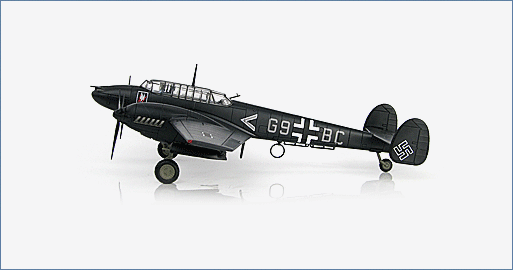Air Power Series>1:72 die-cast display model>BF 110>HA1814
BF 110E-2 G9+BC, Oblt. Uellenbeck, II/N.JG.1, spring 1942

General Background
1(Z)JG77 was called the "Flying Dachshunds" because of the units 3 mascots named Barnsee, Herdia and Lockheed, named after the unit's first victory, a Lockheed Hudson. Painted on the aircraft nose was a Dachshund with a Rata (Polikarpov I-16) in its mouth. While on the Eastern front Lt. Felix-Maria Brandis was the unit CO and scored 14 victories. LN+LR was one of Brandis' aircraft but on February 2, 1942 while flying LN+AR he failed to return from a sortie. In June 1942 LN+LR was lost to AAA fire.
The Aircraft
In January 1942 II./NJG1 transferred to Sint-Truiden/Sint-Trond Belgium at a time when the RAF
was re-evaluating the success of their operations against Germany as well as bad weather for
the first few months of the year meant the need for night fighters was at a low. In February 1942
scoreless II./NJG1 moved to Koksijde so they could take part in what would be “Operation
Cerberus”, the successful breakout from Brest to Germany of the battleships Scharnhorst and
Gneisenau and heavy cruiser Prince Eugen.
Specifications :
Role: |
Designed as a fighter bomber |
| Number Built: | 865 |
| Crew: | 2 |
| Dimensions | |
| Wingspan: | 53 ft 3 in (16.25 m) |
| Length: | 39 ft 7 in (12.07 m) |
| Height: | 13 ft 6 in (4.13 m) |
| Performance: | |
| Powerplants: | 2 x DB 601P 1,175 hp |
| Speed | |
| Maximum: | 350 mph (562 km/h |
| Cruise: | 217 mph (350 km/h) |
| Landing: | 93 mph (150 km/h) |
| Maximum Rate Of Climb: | 2,150 ft/min (11 m/s) |
| Service Ceiling: | 32,000 ft (9,753 m) |
| Range: | 680 miles (1,095 km) |
| Weight: | |
| Empty: | 10,771 lb (4,885 kg) |
| Maximum: | 15,269 lb (6,925 kg) |
| Armament: | 4 x MG17 |
| 2 x MG FF | |
| 1 x MG15 | |
| Bombs: | Maximum 2,204.6 lb (1,000 kg) of bombs under the fuselage And |
| 4 x SC 50 or SC 70 bombs under the wings |

